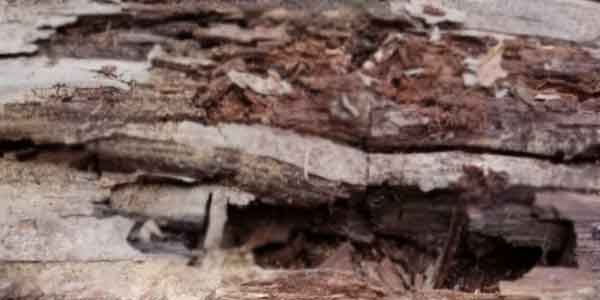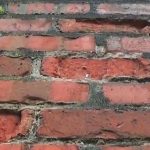The DIY Fix is reader supported. When you buy after clicking a link on our site, we may earn an affiliate commission.
Dry rot is a common type of fungus that affects wood in nature and also inside properties. For the fungus to take hold, it needs a certain level of moisture to germinate and start spreading within timber.
The fungus requires moisture to start growing. This moisture is mainly caused by some type of damp or plumbing leak inside a property. Rising damp is a common cause of dry rot, especially in lower-level timbers in a property. This can include ground floor joists, floorboards, and other timbers, such as architrave and skirting.
Rising damp occurs when ground water travels up through building materials via capillary action. If left untreated it can travel to around one meter above ground level. Obviously, this can cause serious damp issues in a property. Not only will it damage other building materials and decoration, but it is also the catalyst that activates fungal spores.

What is dry rot?
Dry rot is a form of wood attacking fungus. It is common in the UK, as well as many other temperate regions around the world. Here in the UK, the annual spend on treatments for dry rot is estimated to be in the region of £150 million.
Unlike wet rot, dry rot is only caused by one specific type of fungus, known as Serpula Lacrymans. In comparison to wet rot there are several main differences.
- It can germinate at lower levels of moisture saturation in timber. Generally dry rot will only need 20% moisture content in timber to start growing and spreading. Wet rot on the other hand will require a much higher moisture content (30-50%).
- It is more aggressive and can spread. Wet rot tends to be localised to a specific area of moisture. However, dry rot will seek out new timber and can spread as much as 30cm per month. It can also travel through other building materials such as masonry and plaster.
- Appearance. As the name suggests, dry rot physically dries the timber out. It does this by extracting moisture and nutrients such as cellulose, causing the wood to become dry and brittle. Wet rot tends to be softer and spongier as it deteriorates.
Another thing to look for with Dry rot, is hyphae and spores.
The hyphae is a collection of strands that act as a kind of root for the fungus. This will appear on the surface of the wood and is white or slightly yellow, it will have a fluffy appearance not that dissimilar to fluffy cotton wool.
The spores are released by the fungus to spread to nearby surfaces and new timber. The individual spores are microscopic. However, when they collect on a surface, they will form a fine red dust. This red spore dust is one of the easiest ways to identify dry rot.
Rising damp and dry rot
Rising damp can cause dry rot when ground water rises and begins to saturate timbers, such as ground floor joists. However, this does not guarantee dry rot.
For dry rot to form, spores will need to be present in the area. If there are dry rot spores, moisture in the timber will only need to reach 20% before the spores begin to germinate and grow. It can take hold faster than wet rot, which requires much wetter timbers. Once dry rot sets in, it can spread quite quickly, especially if it is not identified early.
The good news is it can be stopped. If you stop the rising damp and dry the timbers below the required 20% moisture content, dry rot will go dormant and stop spreading. At this point you will need to remove all infected timbers. You will also need to remove any wet plaster or decorations that could be infected.
Before you add any new plaster or decorations, you should make sure that all masonry is completely dry. You should also treat adjacent timbers, and all replacement timber should be pre-treated. This is going to be slightly more expensive than untreated timber, but it will be far more resilient to future problems.
DIY damp and rot treatment or professional?
Someone with a reasonable amount of building knowledge, or even a very competent DIY’er, could potentially fix rising damp and dry rot. However, this is an issue that has the potential to spread and cause widespread damp through a property. For this reason, 90% of people should probably hire an expert.
This comes with a few main advantages:
- A professional damp expert will know how to diagnose and repair your rising damp issue. They will also know how to dry the area effectively and ensure that the damp doesn’t return.
- Someone experienced will have dealt with dry rot many times. As a result, they will know how to treat it properly, how to clean and treat the surrounding area, and what timbers need replacing and which ones are safe to leave in.
- Because of the above, and the confidence a professional will have, they will generally offer an extensive timber and damp guarantee (usually 20-30 years).
As you can see the main advantage is the work is guaranteed. It will be done to a high standard, then if for any reason the issue returns, they will come back to fix it.
To find a damp and timber specialist we recommend you compare local quotes from a variety of different companies. By doing this you will get the best price for the work that is required.
The best way to compare prices is via a damp comparison site.
Click here to see our favourite damp and timber comparison site
Conclusion
Rising damp can cause dry rot and dry rot can be very destructive. As soon as you identify dry rot it should be treated ASAP. This will include all repairs to stop the damp rising or penetrating from anywhere else.
It is important to point out, if you do not fix the underlying damp problem, there is a high chance that rot and damage to timbers will occur again in the future.
if you are in any doubt about how this issue needs fixing, it is highly advised you seek the help of a professional. If the problem is not fixed correctly, it can spread and become even more expensive to treat.




